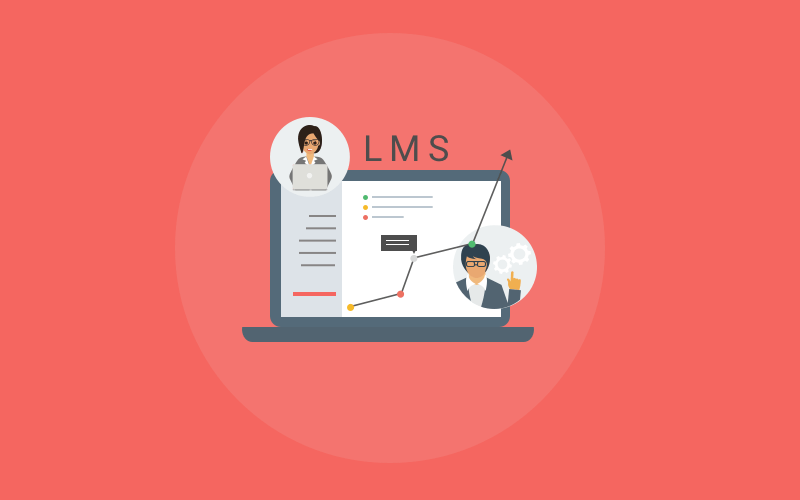What is your understanding of employee management? How do you define it?
If you think it is synonymous with training and development, unthink it.
Because it is much more than learning.
The process of employee management begins with selecting the right candidates. It then progresses to the stages of reward & recognition and discipline.
In this sense, it is more about managing employees to continuously engage and motivate them, ensure increased performance and productivity, and achieve business profitability.
According to the Work Institute’s research over the past few years, nearly two-thirds (63.3%) of departures by employees were due to preventable reasons that are “related to modifiable conditions such as management, total rewards, career issues and aspects of the job itself.”
If you take this into account and look at the flip side, better management resulting in engagement in the workplace brings lower absenteeism and persuades employees to work harder.
In this blog, you’ll learn everything you want to know about employee management, including how to manage them effectively and the employee management tools you can use for the purpose.
Continue reading to find out.
Watch: What Is Employee Training?
What Is Employee Management?
Employee management is a planned approach to managing employees throughout their professional lifecycle in an organization. It covers:
- hiring
- employee management training
- continuous engagement
- performance management
- performance evaluation
- benefits & compensation
- rewards
- discipline
The idea behind employee management is to enable a workforce to conform to a standard of performance and behaviors that closely aligns with business goals. This is intended to translate into increased retention, greater productivity, and growing profitability.
In this sense, you can also call it manpower management.
How Does Employee Management Work?
Employee management works on the basis of successfully managing employee motivation, performance, productivity, and business profitability. The process starts with recruiting the right candidates for the job and extends to providing a conducive environment where your employees can realize their full potential.
A key element in this is cultivating healthy professional relationships with your employees marked by open communication, understanding, cooperation, and trust. Add to this the importance of continuous workplace learning & development.
6 Key Benefits of Managing Employees
Employee management brings some undeniable benefits to employees and businesses. Here are six of them:
1. Employee Engagement
When you invest your time and energy in improving your employees, they feel more engaged. They are more enthusiastic and passionate about their work when you walk along with them towards a goal than they would if you were to leave them to fend for themselves.
Without an engaged employee, it will become increasingly difficult to get anything worthwhile done.
Engagement in the workplace improves the quality of work and makes employees happier.
2. Clarity About Expectations
Well-managed employees are more clear about what’s expected of them. As the renowned business analytics and advisory company Gallup says, clarity of job expectations is one of the most basic employee needs and something vital to performance.
From the start, managers should effectively communicate their team’s goals, what each team member needs to do, and why it is important.
Once your employees are clear about what you expect from them, it becomes easier for them to take the path that leads to their goals and ignore those that don’t.
3. Boost to Motivation
Employee management helps you connect with your employees on a personal level. They feel heard, appreciated, and valued. This impacts their performance and productivity positively.
Helpful steps such as regular feedback from employees can contribute to boosting their motivation. They make employees feel that their opinions matter in making critical business decisions.
4. Improved Efficiency
Managing workflows is an essential part of employee management strategies. For example, through web-based employee performance management software, you can set SMART goals, assign tasks, and track progress consistently. It helps your employees do the right things, the right way, at the right time.
This, in turn, improves employee efficiency, cuts down wastage, and ensures their growth.
5. Better Compliance & Security
Compared to an untrained employee, a properly trained employee is more likely to follow compliance requirements and security protocols in an organization. This is particularly important if you operate in an area like the financial sector or have remote teams spread across the world.
You need to protect your customers’ data and important documents from unauthorized access and theft.
A standard employee management system or employee training software with management functionalities can help you educate your employees on the safe handling of such sensitive information and keep everyone away from unwanted compromise.
6. Less Turnover
The average cost that a business incurs in replacing a salaried employee is estimated to be 6 to 9 months’ salary.
Again, employee management can help you in this.
Effective employee relationship management results in more engaged and satisfied employees. And happier customers are less likely to quit.
This results in reduced employee costs that you would otherwise spend on hiring, training, and retaining new hires.
How to Manage Employees Effectively
Now that you know some of the significant benefits of managing employees, let’s look at how you can manage them effectively.
Set Clear Expectations
A written job description at the time of hiring is not enough to communicate your expectations to employees.
Unless your employees are clear about what they need to do, they will be groping in the dark, and you’ll end up achieving nothing. They won’t be able to do the right thing and will take longer to do it.
That’s why it is important to set clear expectations.
Setting quarterly targets is fine, but equally important is making sure the goals are clear. Otherwise, getting clear results would be difficult.
Also, make it a point to share constructive feedback and motivate employees so that they can course-correct themselves when something doesn’t work out the way it should.
Keep the Lines of Communication Open
An incredible 81% of employees prefer open communication to free meals, health plans, and gym memberships in the workplace.
This underlines the importance of communication with employees.
Make yourself always accessible and keep the door of communication open so that employees can share any concerns or suggestions. This will not only check workflow from becoming stagnant but remove any possible misunderstandings.
Open and honest communication also improves professional relationships by building trust over time.
Provide Growth Opportunities
As many as 32% of employees quit their jobs, citing a lack of career advancement.
Employee management programs become meaningless in the absence of career growth for employees. When employees are confident that your management programs are driven to develop them as one of the goals, they will cooperate and become willing participants.
When you develop your workforce, you develop their talents and their ability to accept challenges, not to mention all the competitive business advantages.
Build Trust
Trust is the engine that propels workplace relationships. When there’s a lack of trust, it stalls progress.
In fact, trust is so important that employees who trust their seniors are 12 times more likely to become invested in their work.
So, how can you build trust in the workplace? Here are some of the ways you can do it:
- Promote transparency in day-to-day operations
- Be honest in what you say and do
- Be consistent
- Make everyone accountable
- Avoid micromanaging
Incentivize Top Performers
Incentives in different forms are inevitable in employee management. They motivate your deserving employees to keep up the good work.
Incentives also play a key role in building an employee-centric culture that benefits the current employees and helps attract new talent.
There are several incentive ideas for employees. For example, a raise, a surprise party, a movie ticket, or a simple thank you note can boost their morale.
When employers motivate their employees through incentive programs, the latter tend to work better and stay longer. This makes the relationship a two-way process.
Get Free Employee Training Software — All Features, Forever.
We've helped 567 companies train 200,000+ employees. Create courses in under a minute with our AI LMS or use 200+ ready-made courses on compliance, harassment, DEI, onboarding, and more!
Major Challenges in Employee Management
Managers, team leaders, and HR face a number of challenges when it comes to employee management. Identifying these challenges and the ways to overcome them is essential to build a goal-driven successful team.
Let’s see some of those common challenges and the best solution for each of them.
Recruiting the Right Candidates
As said in the beginning, the process of employee management starts with attracting and recruiting the right candidates. This is easier said than done. It takes time and effort to land individuals who are the right fit for a position.
Also, there is a shortage of employable people in the job market. Add to that the pain of trying to attract talent when they are considering multiple offers at the same time.
This makes it one of the top challenges for recruitment managers and team leads.
Solution: Look in-house for your open positions and see if there are employees who can take a new role.
You can also adjust the criteria for hiring, meaning instead of waiting endlessly for the best candidates, you can go for the less qualified ones for the post.
Hiring contractual workers while still hunting for longer-term employees is another way you can explore to counteract skill shortage.
Poor Performance
Sometimes, the performance of employees witnesses a downward trend due to many reasons, including personal and professional. Signs of poor performance include:
- the inability to get along with co-workers
- not safeguarding company policies
- the failure to meet business goals
The pressure to perform when they don’t have the inclination to do so can be counterproductive.
Solution: Conduct a workflow analysis to identify bottlenecks and inject efficiency into the process.
Set up a one-on-one meeting to understand what’s holding your employees from giving their best shot.
This will enable you to go to the root cause of lack of performance.
Absence of a Workflow Structure
Every professional team needs a well-defined structure for workflow management, from initiation to completion. Every team member should know what tasks they need to perform, when, and how.
In the absence of such instructions and structure, there will be chaos, delays, and redundancy in activities that can make the managers’ job difficult.
Solution: An employee task management software or project management tool can help you in planning, assigning, monitoring, and evaluating a series of essential tasks.
Along with this, every employee should be briefed at the outset about their work responsibilities, deadlines, available support resources, and so on.
Time Management
Generally, managers have a lot on their plate and often spread themselves too thin. Some of the major problems that affect proper time management include, failure to prioritize tasks, procrastination, lack of punctuality, miscalculating the time and effort a task will take, and letting distractions get the better of oneself.
The result is that you’ll end up achieving nothing in the end.
Solution: Schedule different tasks that your team needs to perform in a day by assigning a time slot to each.
Ensure your team members always organize themselves to deliver a task on time, eliminate rush and stress, and increase productivity. Here a tool like DeskTime can be highly effective.

Make it a practice to delegate tasks whenever possible and automate repetitive tasks. Never make the mistake of doing everything yourself.
Also, remove any kind of distraction from the work environment.
Ongoing Training & Development
As a part of your employee management responsibilities, you’ll come across the need to create and sustain a culture of continuous learning.
The challenge here is that you will need the right employee training tool for the purpose, the right environment, and your employees should be motivated enough to participate in the process willingly. Only then you’ll be able to meet your learning goals, including that of developing tomorrow’s leaders.
Solution: Adopt a learning management system (LMS) that takes care of every stage of an employee development program, from course creation to assessment. Provide rewards to employees who go out of their way to learn and upskill themselves.
Along with this, personalize your training programs to meet each individual’s needs for development and growth.
Working With Difficult Employees
At times, managers have to work with difficult employees who don’t pay heed to instructions, don’t play by the rules, and give a hard time to every team member. Such situations breed disappointment and anger.
Solution: Consider listening to your employees and take feedback on any concerns they might have regarding their work, colleagues, or personal issues.
Never ignore the problem. If necessary, enlist the help of HR personnel.
All these steps will help you identify the problem and resolve it before it gets out of hand.
While there are many tasks that can be simply managed manually, automation saves the day for several others. As discussed above, having the right tool is important to build and maintain a culture of continuous learning, manage time effectively and productivity as well. This brings us to the discussion about software programs that let you do this and more.
What Is Employee Management Software?
Employee management software is an online employee management system designed to plan, manage, execute, and evaluate employee management programs. It is used to monitor employee engagement, learning, and performance.
Time tracking and workforce productivity tools are also a part of such solutions.
You can also manage employee information in employee management software, including their names & addresses, emergency contacts, job roles, promotions, leaves, and termination of employment.
In this sense, such software stores both personal and professional information securely. This enables you to add, modify, retrieve, and share information about employees easily and quickly.
More importantly, it offers a platform for managers to assign, manage, and assess various employee training programs to develop employee skills.
Why Choose ProProfs for Employee Management?
ProProfs is a simple employee learning management software. It is used by 15+ million people in more than 150 countries. They rely on it to build smarter employees and happier customers. Awesome customer support complements the tools that it offers to users.
Easy to Use
ProProfs is the world’s easiest cloud LMS. It is designed for users of all skill levels and businesses of all sizes. No software download and installation required. No need for specialized knowledge.
Virtual Classroom
A centralized and secure online classroom makes it easy to manage learners, courses, announcements, and other learning activities using a single dashboard.
Engaging Quizzes
Launch engaging quizzes for assessment from within a course. Make learning exciting and identify and bridge knowledge gaps easily.
70+ Languages Supported
ProProfs speaks over 70 languages, including English, Spanish, Japanese, and French. Training learners in a language they understand has never been this easy.
Discussion & Collaboration Tool
An online Q&A community enables learners to engage in social learning. Provide access to peer knowledge and wisdom. Facilitate real-time discussion and collaboration. Never leave a good question unanswered.
AI-Powered Reporting
Reporting & analytics tool in ProProfs gives a bird’s eye view of learners’ progress, engagement level, and course completion rate. If necessary, you can adjust how you deliver training based on these stats to get better results.
Make the Most of Your Employee Management
Employee management is key to strategic hiring, effective onboarding and training, and performance and productivity management. Well-managed employees are more efficient, productive and ensure greater compliance and security.
The goal is to align these activities with employee development and business objectives.
If you need any help setting up and executing employee management training, we can help. ProProfs is a one-stop solution for learning management that offers not only an LMS but a growing library of courses and templates. Manage the entire employee lifecycle with ease using this learner-centric platform.
 Tips
Tips
We’d love to hear your tips & suggestions on this article!
Get Free Employee Training Software — All Features, Forever.
We've helped 567 companies train 200,000+ employees. Create courses in under a minute with our AI LMS or use 200+ ready-made courses on compliance, harassment, DEI, onboarding, and more!

 We'd love your feedback!
We'd love your feedback! Thanks for your feedback!
Thanks for your feedback!






